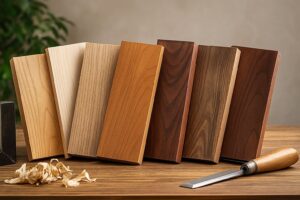
When it comes to custom doors and millwork, the wood species you choose plays a vital role in both aesthetics and performance. Each type of wood has its own unique grain, color, durability, and cost considerations. Whether you’re designing a bold entry door, elegant interior French doors, or intricate mouldings and trim, selecting the right wood species ensures that your investment stands the test of time—both in style and in function.
In this guide, we’ll explore the best wood species for custom doors and millwork, comparing their strengths, uses, and design appeal. By the end, you’ll have a clear understanding of which options best align with your home’s style, your budget, and your long-term needs.
Why the Wood Species Matters
Custom wood doors and millwork are more than decorative features—they add character, structure, and value to your home. The right wood species impacts:
- Durability: How well the door resists dents, scratches, and weather changes.
- Aesthetic appeal: The grain, texture, and tone of the wood create a signature style.
- Maintenance needs: Some woods require more care to keep their finish looking pristine.
- Energy efficiency: Dense hardwoods can improve insulation, making your home more comfortable.
- Customization potential: Certain species are easier to stain, carve, or shape for custom designs.
Popular Wood Species for Custom Doors and Millwork
1. Mahogany – The Gold Standard for Custom Doors
Mahogany has long been considered one of the best woods for high-end doors and millwork.
- Appearance: Rich reddish-brown color with a straight, consistent grain.
- Durability: Extremely strong and resistant to swelling, warping, and decay.
- Best Uses: Exterior entry doors, French doors, crown mouldings, and custom panels.
- Why Choose It: Offers a luxurious look that elevates the curb appeal of any home.
Mahogany is also a great insulator, making it ideal for front doors where energy efficiency is key.
2. Oak – Classic and Timeless
Oak is one of the most widely used woods in traditional and modern interiors alike.
- Appearance: Distinctive grain patterns, available in red or white oak.
- Durability: Dense, strong, and wear-resistant, perfect for high-traffic areas.
- Best Uses: Interior panel doors, stair railings, baseboards, and window casings.
- Why Choose It: Provides a balance of beauty, strength, and affordability.
Red oak has a warm, reddish tint, while white oak leans toward cooler, grayish hues—making both versatile choices.
3. Walnut – Elegant and Sophisticated
Walnut is a top choice for homeowners looking for a refined, dark-toned wood.
- Appearance: Deep chocolate brown with rich grain variation.
- Durability: Strong, stable, and less likely to warp than softer species.
- Best Uses: Interior panel doors, millwork accents, and decorative trim.
- Why Choose It: Perfect for creating a dramatic, high-end interior design statement.
Walnut works especially well in modern and transitional homes where contrast is key.
4. Cherry – Warm and Versatile
Cherry is prized for its natural luster and smooth grain.
- Appearance: Reddish-brown that darkens beautifully over time.
- Durability: Medium density, making it easier to work with while still offering resilience.
- Best Uses: Interior French doors, custom cabinetry, and mouldings.
- Why Choose It: Ages gracefully and complements both classic and modern styles.
5. Maple – Smooth and Modern
Maple’s clean appearance makes it a favorite for contemporary millwork.
- Appearance: Pale cream to light brown with subtle grain.
- Durability: Very hard and resistant to abrasions.
- Best Uses: Sleek panel doors, modern trim, and minimalist moulding profiles.
- Why Choose It: Works well for homeowners who want a simple, clean design that can be stained or painted.
6. Cedar – Naturally Resistant to the Elements
Cedar is valued for its natural oils that resist moisture, insects, and decay.
- Appearance: Light reddish tones with a rustic grain.
- Durability: Excellent resistance to rot and humidity, though softer than hardwoods.
- Best Uses: Exterior doors, siding, and outdoor millwork.
- Why Choose It: Ideal for homeowners in humid or coastal climates.
7. Pine – Affordable and Adaptable
Pine is a popular choice for homeowners seeking affordability without sacrificing charm.
- Appearance: Light yellowish wood with knots for a rustic look.
- Durability: Softer than hardwoods, but works well for interior projects.
- Best Uses: Interior panel doors, baseboards, and custom trim.
- Why Choose It: Cost-effective and versatile, especially when painted.
Choosing the Right Wood for Your Project
When selecting the wood species for your custom doors and millwork, consider the following:
- Location – Exterior doors require dense, weather-resistant hardwoods like mahogany, oak, or cedar.
- Style preference – Sleek modern homes often look best with maple or walnut, while traditional homes shine with oak or cherry.
- Budget – Pine offers affordability, while exotic hardwoods like mahogany or walnut deliver luxury.
- Maintenance – Some species like mahogany require regular sealing, while others like maple are easier to maintain.
Bringing It All Together
The wood species you choose for your custom doors and millwork is more than just a material decision—it’s a design choice that defines your home’s character, durability, and value. Whether you opt for the timeless beauty of oak, the sophistication of walnut, or the weather resistance of cedar, each species offers unique benefits.
If you’re ready to design a one-of-a-kind space, working with skilled craftsmen ensures your chosen wood is transformed into custom doors and millwork that blend style with long-lasting function.
Bring Your Vision to Life with Traditional Door
Discover the perfect wood species for your custom doors and millwork. Call (289) 207-5128 today or request a quote online to start your project with Traditional Door.
